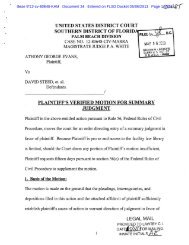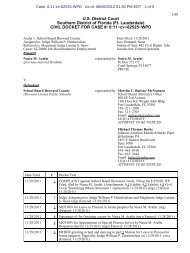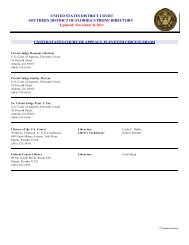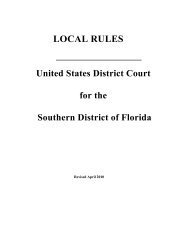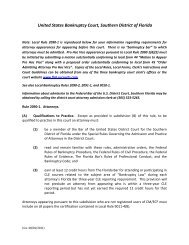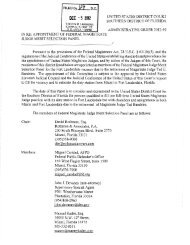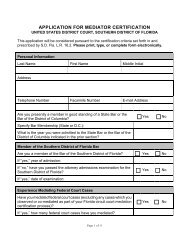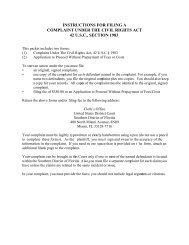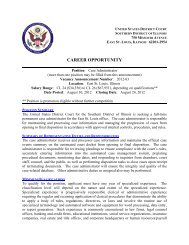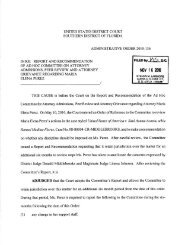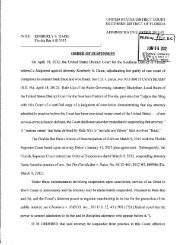JAN j 6 2010 - United States District Court
JAN j 6 2010 - United States District Court
JAN j 6 2010 - United States District Court
Create successful ePaper yourself
Turn your PDF publications into a flip-book with our unique Google optimized e-Paper software.
Procedure 45(a)(2) subpoena for deposition or production of documents,<br />
electronically stored information or things seeks relief from the <strong>Court</strong><br />
pertaining to the subpoena, the motion seeking such relief must be filed<br />
in the district in which the deposition is to take place. Leaving no<br />
doubt about the drafter's intentions when revising the rule, the<br />
Commentary to Federal Rule of Civil Procedure 45(a)(2), states as<br />
follows:<br />
Pursuant to Paragraph (a) (2) , a subpoena for a deposition must still<br />
issue from the court in which the deposition or production would be<br />
compelled. Accordingly, a motion to quash such a subpoena if it<br />
overbears the limits of the subpoena power must, as under the previous<br />
rule, be presented to the court for the district in which the deposition<br />
would occur.<br />
Commentary to 1991 Amendment to Sec Federal Rule of Civil Procedure 45.<br />
D. Non-stenographic Recording of Depositions.<br />
(1) Videotape Depositions. Videotape depositions and recordation by<br />
other non-stenographic means may be taken by parties without first having<br />
to obtain permission from the <strong>Court</strong> or agreement from counsel. Federal<br />
Rule of Civil Procedure 30(b)(2). With prior notice to the deponent and<br />
other parties, any party may designate another method to record the<br />
deponent's testimony in addition to the method specified by the person<br />
taking the deposition and the notice or cross-notice of deposition shall<br />
state the method by which the testimony shall be recorded. See Federal<br />
Rule of Civil Procedure 30(b)(3).<br />
The following procedures are commonly followed when the deposition is<br />
recorded by a non-stenographic means:<br />
a. If the deposition of the witness is recorded on videotape or other<br />
non-stenographic means, the testimony of the witness does not have to be<br />
recorded by a certified stenographic reporter and transcribed in the<br />
usual manner, unless such transcripts are to be offered to the <strong>Court</strong>.<br />
See Federal Rules of Civil Procedure 30(b) and 32(c).<br />
b. Prior to the taking of any deposition, the witness shall be first duly<br />
sworn by an officer authorized to administer oaths, before whom the<br />
deposition is being taken. If the deposition is recorded other than<br />
stenographically, the officer designated by Federal Rule of Civil<br />
Procedure 28, shall state on the record (a) the officer's name and<br />
business address, (b) the date, time and place of the deposition, (c) the<br />
deponent's name, (d) administer the oath, and (e) identify all parties<br />
present. Items (a) through (c) must be repeated at the beginning of each<br />
unit of recorded tape or other recording medium. See Federal Rule of<br />
Civil Procedure 30(b)(4).<br />
c. If any objections are made, the objections shall be ruled upon by the<br />
<strong>Court</strong> on the basis of the stenographic transcript, and if any questions<br />
or answers are stricken by the <strong>Court</strong>, the videotape and sound recording<br />
must be edited to reflect the deletions so that it will conform in all<br />
respects to the <strong>Court</strong>'s rulings.<br />
92



